Advances in dairy Research
Open Access
ISSN: 2329-888X
ISSN: 2329-888X
Research Paper - (2021)Volume 9, Issue 2
The purpose of the study was to quantify the economic loss due to delayed conception in dairy cows and heifers in central highlands of Ethiopia using data collected from 298 randomly selected dairy farmers of Oromia and Amhara national regional states. The study covered two zones of Oromia (Finfine special zone and North Shoa) and one zone of Amhara (North Shoa). A three-stage sampling technique was employed to select the sample for the study which involved purposive and random sampling techniques. The data collection was done using a structured questionnaire. Both descriptive and inferential statistics were used to analyze the data. The total loss due to poor reproductive performance per year per cow/heifer was the aggregate of milk loss, extra feed cost, extra medical cost, breeding cost, calf loss, and extra labor. The result of the study revealed that the mean annual cost of the poor reproductive performance of the crossbreed cow was ETB 32,068.53 (US $1,167.40) with the mean per day cost of ETB 157.43 (US $5.73). On the other hand, the mean annual cost of poor reproductive performance of local zebu cows was ETB 15,696.34 (US $571. 39) with the mean per cow per day cost of ETB 54.90 (US $2.00). Based on the results, a high proportion of poor reproductive performance cost of crossbreed cows goes to milk loss (53%) and extra feed cost (39%), and the highest proportion goes to cost of milk loss (53%) and cost of extra feed (33%) for local zebu cows. Concurrently, the cost of poor reproductive performance (delayed conception) for crossbreed heifers was ETB 69,333.59 (US $2,523.97) with a mean per heifer per day cost of ETB 151.75 (US $5.52), and the mean cost of poor reproductive performance of local zebu heifers along the study zones was ETB 27,010.75 (US $ 983.28) with a mean per day per heifer cost of ETB 52.56 (US $1.91). More than 55% of the cost goes to milk loss for both crossbreed and local zebu heifers. The study has also estimated the cost of delayed conception in central Ethiopia. The estimated result showed that poor reproductive performance of crossbred cows annually costs ETB 2,053,022,879.41 (US $74,736,908.61). On other hand, poor reproductive performance of local zebu cattle costs ETB 14,802,637,790.05 (US $538,865,591.19). Thus, it is suggested to work on AI efficiency, timely culling, and using crossbreed dairy cattle to reduce the economic losses caused by delayed conception.
Crossbreed; Culling; Delayed conception; Local zebu and poor reproductive performance
The dairy industry occupies a special position among the other sectors of agriculture. It gives a regular income to the numerous producers and provides a lot of employment. In Ethiopia, the dairy sub-sector has the potential to be economically viable and contribute to poverty alleviation, food security, improved family nutrition, income, and employment generation [1]. The subsector contributes 40% to agricultural GDP and 12-16% to national GDP [2].
The objectives of various livestock related policies of the successive regimes in Ethiopia have been to improve commercial dairy products in selected areas of the country through an introduction of exotic and crossbred cattle and related feed and management technologies, and development of a milk processing industry to supply the Addis Ababa market and other towns. The policy instruments and operational procedures employed to achieve these goals varied over time, reflecting the politico-economic philosophy of the respective governments. Moreover, the short term dairy policies focus on the increasing the supply of milk and milk products by improving productivity through selection and management, and the long term policy on dairy development focus on the improvement of productivity of the available resource in terms of milk by improving the genetic merit of the animals, raising the quantity of the feed available to livestock and improving management at all levels from production to preservation, collection, processing, and marketing of dairy products without losing any of its inherent quality and quantity. This is expected to supply an adequate amount of milk, both in quantity and quality to satisfy the minimum per capita requirement of milk for the whole population [3].
Because of the emphasis given to the sub-sector, the total volume of milk produced in Ethiopia has progressively increased over the last one and half decades from less than 1 billion liters to 3 billion liters in 2014/15. The government has planned to double domestic milk production between 2015 and 2020 both to decrease imports and launch the export of dairy products. This requires investments and improvements in yields of fodder crops, feeding, genetics, health, and dairy processing [2]. Despite the ambition, shortage, and cost of feed, frequent occurrence of disease, expensive veterinary services, lack of timely Artificial Insemination (AI), financial and marketing problems, the poor productive performance of dairy cows/heifers were the main constraints limiting the dairy sector in the country.
The poor reproductive efficiency of dairy animals i.e. increases in calving intervals due to the decrease in the rate of conception, sometimes said to be infertility, has become a leading expensive health issue in the dairy industry [4,5]. It has both direct and indirect effects throughout the farm system. Poor fertility reduces genetic gain, increases veterinary costs, decreases milk production, disrupts the pattern of milk production, cuts calf sales, and increases the cost of AI. The problem of delayed conception finally leads to involuntary culling and increased calving interval which contributes to economic loss [6,7].
The Ethiopian highlands possess a high potential for dairy development. It occupies the central part of Ethiopia, covers over 40% of the country area, and is the largest of their kind in Sub- Saharan Africa. In the highland areas, the agricultural production system is predominantly subsistence smallholder mixed farming, with crop and livestock husbandry typically practiced within the same management unit. There is no report which is available on the economic losses associated with delayed conception in central highlands even as a country under intensive and smallholder management. Thus, this study has been conducted to determine and quantify the economic loss of delayed conception in dairy cattle under peri-urban and smallholder dairy farming systems of central highlands of Ethiopia. Besides, the study has suggested farmers’ level solutions for reducing the economic loss of delayed conception.
During the lifetime of an individual female, higher reproductive efficiency yields more calves for use as replacements or for sale in the herd, as well as more lactations and therefore milk. These considerations become more important as rearing conditions become more intensive, where expenses for labor and feed have to be compensated for higher income. In order to fulfill its role as an economically useful animal to its owner, dairy heifer/cow grow rapidly from birth until puberty, attain puberty at an early age, conceive readily to a fertile mating, produce a viable calf, produce adequate milk for the calf and extra for sale, return to estrus early during the postpartum period and conceive again and continue to produce calves and milk at regular intervals till the end of its productive life [8]. Puberty is the first behavioral estrus accompanied by the evolution and development of a normal corpus luteum in the ovary. The age at which cattle attain puberty varies between 12 and 40 months. The main factors which influence the age of attainment of puberty are genotype, nutrition, and management, thermal environment, year or season of birth, parasites, and diseases. Under optimum conditions, taurine cattle and their crosses attain puberty earlier than zebu cattle. However, zebu cattle generally have a longer productive life than taurine cattle and some of the late puberty is compensated for by their longevity. Adult non-pregnant heifers and cows normally undergo regular estrus cycles, which have a mean duration of 21 days. The mean duration of gestation is 285 days in zebu cattle and 280 in taurine dairy breeds. Hence, the calving interval should be 365 and 360 for zebu and taurine cattle respectively. After calving, the reproductive tract of the cows goes through a period of recovery called involution, during which the uterus returns to its non-pregnant size and state. Thus, after calving the cow normally shows signs of heat within 30-60 days and must be pregnant by 80-85 days to be economically efficient. According to Falvey and Chantalakhana [8], in Ethiopian highlands, the calving interval for zebu cattle was 26 months, and age at first calving ranged from 23-58 months under traditional management conditions (Table 1).
| Particulars | Optimum | Acceptable |
|---|---|---|
| Age at puberty (months) | < 18 | < 24 |
| Age at first calving (months) | < 30 | < 36 |
| Calving to first service (days) | < 60 | < 90 |
| Calving to conception (days) | < 85 | < 115 |
| Calving interval (months) | 12-13 | 13-14 |
| Service per conception | < 1.6 | < 1.8 |
Table 1: Optimum and acceptable reproductive indices of dairy cattle under optimum condition.
Study area
The study was conducted in three zones (two from Oromia and one from Amhara). Finfine special zone and North Shoa zone are from the Oromia regional state and North Shoa zone of Amhara regional state.
Fin-fine special zone
Oromia Special Zone Surrounding Finfine (Addis Ababa) is found in the central part of the Oromia Regional State, surrounding the capital city-Finfine. It consists of six districts namely Akaki, Berek, Mulo, Sebeta-Awas, Sululta, and Welmera, and eight major towns. The major food crops produced in the zone are cereals, pulses, oilseeds, and others. Among cereals, teff, barley, and wheat are the pre-dominant and among pulses horse beans and, field peas are grown widely. Other crops include vegetables, fruits, root crops, and stimulants are also grown. The area under cereals covers the largest part of the total area of the Zone. The area is the major milk shed of the country. Different dairy improved technologies and practices has been generated and disseminated by Holeta Agricultural Research Center for the area including improved dairy cattle. Welmera is a district sampled for this study.
North Shoa-Oromia Zone
The zone shares common boundaries with the East Shoa zone to the southeast, west Shoa zone to the southwest, and Amhara National Regional State to the north, northeast, and Finfine surrounding zone in the south. Teff, wheat, barley, maize, sorghum, horse beans, field peas, lentils, chickpeas, vetch, Niger seed, rapeseed, and linseed are the most widely cultivated crops in the zone. Livestock rearing is a common agricultural activity in the zone. The area is also prominent milk supplier to Addis Ababa city. Two districts namely Degem and Debrelibanos districts were selected for the study.
North Shoa-Amhara Zone
The agro-ecology is predominantly highland with few areas of midland. Most parts of the zone are hilly or mountainous, but there are some plains. It is an agricultural economy in which livestock rearing makes an important contribution to household incomes. The area is known for its moderately good productivity and is considered to be self-sufficient in grain. Teff, beans, wheat, and pulses are ranked in importance in terms of cash earned from sales. Sheep, cattle, poultry, and a few goats and equines are the livestock kept in the area. The source of animal feed is pasture and crop residues. Livestock possession, particularly oxen holding, and cultivated land area are the main determinants of wealth. Shortage of rain, crop pest and diseases, and livestock diseases are the main hazards which affect crop and livestock [9]. Basona Werana and Angolelana Tera districts of the zone were selected for the study.
A three-stage sampling technique was employed to select the samples for the study which involved both purposive and random sampling techniques. First, regions, zones, and districts were purposively selected based on the dairy sector and dairy investment potential. Then, kebeles were picked randomly and, finally, dairy farmers/ households were randomly selected from the sampling frame/ list of farmers/ exist at kebele level. A total of 298 dairy farmers were selected and interviewed from Oromia and Amhara national regional states. Finfine special zone and north Shoa-Oromia zone from Oromia, and north Shoa-Amhara were selected for the study. A total of 564 crossbreeds and 152 local zebu cattle were examined (Table 2).
| Zones | Districts | Number of households | The proportion of households (%) | Number of Kebeles |
|---|---|---|---|---|
| Finfine Special zone | Wolmera | 52 | 18 | 3 |
| North Shoa Oromia | Degem | 60 | 20 | 2 |
| Debrelibanos | 66 | 22 | 2 | |
| North Shoa Amhara | Basona Werana | 60 | 20 | 2 |
| Angolelana Tera | 60 | 20 | 2 | |
| Total | 298 | 100 | 11 | |
Table 2: Sample areas and proportion of study households.
Primary quantitative data was collected through a structured questionnaire administered to sampled farmers using CSPro version 7.0. Before the actual survey, the questionnaire was pretested in non-sampled villages. The pretest was not only used to test the appropriateness of the tool in collecting the required data but also to evaluate the trained enumerators on the capability of administering the questionnaire. Information related to dairy production, reproduction, and utilization was gathered from the respondents. Farmers' perception of dairy cows and heifer’s poor reproductive performance was also assessed. Households' socio-demographic, institutions, and economic features were also collected. Moreover, data of cattle calving interval, age at first calving, lactation length, milk yield, milk price, production and reproduction costs, and other important variables were collected and analyzed.
Both descriptive and inferential statistics were used to analyze the gathered and cleaned data. Percentage, frequency, the mean, and standard deviation were used to summarize different variables. Moreover, ANOVA was used to compare the data for different variables among zones. Decreasing the reproductive efficiency of a dairy herd affects its profitability through compact incomes and extra expenditures. The total loss due to poor reproductive performance per year per cow was the aggregate of milk loss, extra feed cost, extra medical cost, breeding cost, calf loss, and extra labor.
Milk loss
Extension in calving interval extends the current milk yield period but the overall milk yield declines due to the delay in the initiation of the next lactation [10]. The value of milk loss depends on mean productivity, days delayed, and milk price. The milk price used was according to the information given by the farmers regarding per liter milk prices in their area. The milk loss due to poor reproductive performance was calculated as follows:
VML = MMY x DD ……………………………………………. (1)
Where VML is Value of Milk Loss per Cow, MMY is Mean Milk Yield liter per day and DD is Days Delayed.
Extra feed cost
Extra feed cost was gathered from each respondent for each feeding regime they used to feed. The feed cost (ETB/Day/Cow) was gathered and analyzed for both crossbreed and local zebu cattle. The extra feed cost due to delay in conception was calculated as:
EFC = PDFC × DD …………...…………………………….…. (2)
Where EFC is Extra-Feed Cost per cow, PDFC is Per Day Feed Cost per cow and DD is Days Delayed.
Extra labor cost
It is known that dairy farming is a labor-intensive activity. The extra labor cost per cow per day is the product of per day labor cost per cow and number of days delayed.
ELC = PDLC × DD………………………………………. (3)
Where ELC is Extra-Labor Cost per cow, PDLC is Per Day Labor Cost per Cow and DD is Days Delayed.
Extra treatment cost
Disease treatment, both modern and traditional healers, and vaccination are two important costs of the cattle treatment cost. The extra treatment cost is calculated as:
ETC = PDTC × DD………………………………………………. (4)
Where ETC is Extra-Treatment Cost per cow, PDTC is Per Day Treatment Cost per cow and DD is Days Delayed.
Extra breeding cost
Breeding cost is the cost paid to AI service, AI experts, and service of a bull for breeding and other hidden cost related to this. The cost highly depends on the frequency of service provided to the cow/heifer. It is calculated as:
EBC = NSPC × PPS …………………………………………………... (5)
Where EBC is Extra-Breeding Cost per cow, NSPC is Number of Services per Conception per cow and PPS is Price per Service.
Value of Calf loss
The most important benefit dairy farmers expect from the sector is a calf. The value of calf loss due to delayed conception is given by:
 ……………………(6)
……………………(6)
Where VCL is Value of Calf Loss, DD is Days Delayed, AD is Acceptable Days and MPC is Market Price of Calf.
Total loss due to poor reproductive performance
The total loss due to poor reproductive performance or delayed conception (TL) is the sum of all costs mentioned above and given by:
TL = EFC + ELC + ETC + EBC + VML + VCL…………………… (7)
Per day lost due to poor reproductive performance
Per day loss per cow/heifer (PDL) due to delayed conception is the ratio of total loss (TL) to the total number of days delayed per lactation or year (DD).
 …………………… (8)
…………………… (8)
Characteristics of the sample households
The descriptive result of the study showed that 95% of the respondents were male-headed and the rest 5% were female-headed households. The mean age of household head was 45 years with the highest at North Shoa Amhara zone and the lower at North Shoa Oromia zone. The mean completed years of the education level of the sample showed the highest education level in the Finfine special zone and the lowest in north Shoa-Amhara zone with the overall mean of 3.93 years which is statistically significant at 10% significance level.
The average dairy farming experience was 11.64 years which is statistically different among study zones at a 5% significance level. The mean family size was 6 persons which are the highest in the North Shoa-Oromia zone and the lowest in the North Shoa- Amhara zone (Table 3).
| Particulars | Finfine Special Zone (n=52) |
North Shoa Oromia (n=126) |
North Shoa Amhara (n=120) |
Overall (n=298) | P-value | ||||
|---|---|---|---|---|---|---|---|---|---|
| Mean | SD | Mean | SD | Mean | SD | Mean | SD | ||
| Head age | 46.10 | 12.98 | 43.48 | 12.14 | 46.74 | 12.43 | 45.23 | 12.46 | 0.108 |
| Head education (yrs.) | 4.58 | 4.08 | 4.22 | 3.55 | 3.33 | 3.59 | 3.93 | 3.69 | 0.062* |
| Dairy farming experience | 10.44 | 13.64 | 15.42 | 10.56 | 14.93 | 11.66 | 14.36 | 11.64 | 0.027** |
| Family size 17-50 yrs. | 3.06 | 1.73 | 3.07 | 1.82 | 3.11 | 1.75 | 3.09 | 1.77 | 0.972 |
| Total family size | 6.06 | 2.02 | 6.21 | 2.63 | 5.94 | 2.22 | 6.08 | 2.34 | 0.667 |
Table 3: Sociodemographic characteristics of respondents.
The sample farmers of the north Shoa-Oromia zone owned significantly the largest land size compared to the other zones. The mean landholding in the study area was 3.33 hectares. Large land for hay grass, grazing land, and improved forage land was allocated by the farmers of the North Shoa Oromia region where relatively larger total land exists. A large proportion of land for livestock feed was allocated at the North Shoa-Oromia zone and a low proportion at Finfine special zone. The area is also known for commercial hay production and supply. The mean land allocated to feed was 28% which is significant at a 5% significance level (Table 4).
| Land size in hectares | Finfine Special Zone (n=52) |
North Shoa Oromia (n=126) |
North Shoa Amhara (n=120) |
Overall (n=298) | P-value | ||||
|---|---|---|---|---|---|---|---|---|---|
| Mean | SD | Mean | SD | Mean | SD | Mean | SD | ||
| Total land owned [A] | 2.88 | 1.99 | 3.68 | 1.80 | 3.16 | 1.71 | 3.33 | 1.82 | 0.012** |
| Homestead land [B] | 0.18 | 0.09 | 0.44 | 0.78 | 0.22 | 0.12 | 0.31 | 0.53 | 0.001*** |
| Cropland [C] | 1.77 | 1.31 | 1.99 | 1.24 | 2.01 | 1.23 | 1.96 | 1.25 | 0.498 |
| Forest/tree land [D] | 0.20 | 0.52 | 0.07 | 1.65 | 0.12 | 0.21 | 0.11 | 0.28 | 0.014** |
| Grazing land [E] | 0.44 | 0.79 | 0.49 | 0.57 | 0.48 | 0.63 | 0.48 | 0.64 | 0.877 |
| Hay grassland [F] | 0.23 | 0.71 | 0.39 | 0.60 | 0.23 | 0.26 | 0.29 | 0.52 | 0.029** |
| Improved forage land [G] | 0.03 | 0.09 | 0.24 | 0.40 | 0.13 | 0.22 | 0.16 | 0.31 | 0.000*** |
| Cattle feed [E+F+G] | 0.70 | 0.63 | 1.12 | 0.89 | 0.84 | 0.77 | 0.93 | 0.90 | 0.031*** |
| % allocated to cattle feed | 24 | 30 | 27 | 28 | 0.046** | ||||
Table 4: Land ownership of respondents.
Livestock production and reproduction on the study areas
The central highland of the country is characterized by mixed and subsistence farming. Livestock rearing is an important agricultural activity in the area. Livestock plays important role in terms of income, traction power, nutrition, and other socio-economic roles. A prominent amount of milk is also supplied to the capital city of Ethiopia; Addis Ababa from these three areas.
Livestock ownership
The result of the survey showed that household’s cattle holding was low which realized the mixed farming feature of the area. The mean crossbreed cow holding was 1.88 and the mean number of local zebu cow holding was 0.65 (number) which both are statistically different in number among the study zones. On the other hand, the mean number of lactating cows was 1.66 cows which are high in the north Shoa-Oromia zone and low in the North Shoa-Amhara zone (Table 5).
| Livestock | Finfine Special Zone (n=52) |
North Shoa Oromia (n=126) |
North Shoa Amhara (n=120) |
Overall (n=298) | P-value | ||||
|---|---|---|---|---|---|---|---|---|---|
| Mean | SD | Mean | SD | Mean | SD | Mean | SD | ||
| Crossbreed cows | 0.98 | 1.27 | 2.37 | 1.73 | 1.75 | 0.78 | 1.88 | 1.43 | 0.000*** |
| Local cows | 1.73 | 2.05 | 0.36 | 0.89 | 0.50 | 0.78 | 0.65 | 1.24 | 0.000*** |
| Crossbreed heifers | 0.48 | 0.87 | 0.96 | 0.88 | 0.71 | 0.77 | 0.78 | 0.85 | 0.001*** |
| Local heifers | 0.65 | 0.97 | 0.14 | 0.43 | 0.15 | 0.48 | 0.23 | 0.61 | 0.000*** |
| Crossbreed oxen | 0.29 | 0.75 | 1.18 | 1.28 | 1.35 | 1.03 | 1.09 | 1.16 | 0.000*** |
| Local oxen | 2.17 | 1.45 | 0.92 | 0.94 | 0.88 | 0.98 | 1.12 | 1.11 | 0.000*** |
| Crossbreed bulls | 0.33 | 0.86 | 0.52 | 1.49 | 0.37 | 0.69 | 0.42 | 1.12 | 0.464 |
| Local bulls | 0.50 | 1.02 | 0.09 | 0.35 | 0.12 | 0.48 | 0.17 | 0.58 | 0.000*** |
| Crossbreed calves | 0.81 | 1.14 | 1.16 | 1.11 | 1.26 | 0.90 | 1.14 | 1.04 | 0.032** |
| Local calves | 0.87 | 1.03 | 0.17 | 0.46 | 0.28 | 0.62 | 0.33 | 0.70 | 0.000*** |
| Lactating cows | 1.71 | 1.26 | 1.75 | 0.96 | 1.55 | 0.82 | 1.66 | 0.97 | 0.243 |
Table 5: Farmers livestock ownership in the study zones.
Milk yield
The productivity of cows in the study zones was also seen in the study. The result showed that the mean productivity of milk for crossbreed cows was 8.04 lit.day-1 which was high in the north Shoa- Amhara zone (8.23) and lower in the Finfine special zone (7.68 lit. day-1). Local zebus milk yield also revealed that high productivity of milk was observed at north Shoa Oromia (3.27 lit.day-1) and the lowest was observed at Finfine special zone (2.38 lit.day-1) with a mean of 2.82 lit.day-1. The result revealed significant local zebu milk yield differences among the study zones at 5% (Table 6). Recent empirical studies showed that the average daily milk yield of exotic cows were 8.78 lit.day-1 and 5.83 lit.day-1 for the urban and peri-urban areas, respectively. On the other hand, the average daily milk yield of local cow was 2.56 lit.day-1 and 1.87 lit.day-1 for the urban and peri-urban areas, respectively [11].
| Daily milk yield (lit.day-1) | Finfine Special Zone (n=52) |
North Shoa Oromia (n=126) |
North Shoa Amhara (n=120) |
Overall (n=298) | P-value | ||||
|---|---|---|---|---|---|---|---|---|---|
| Mean | SD | Mean | SD | Mean | SD | Mean | SD | ||
| Crossbreed Cow | 7.68 | 2.81 | 7.98 | 3.25 | 8.23 | 2.58 | 8.04 | 2.96 | 0.550 |
| Zebu/Local Cow | 2.38 | 1.52 | 3.27 | 1.24 | 3.26 | 1.73 | 2.82 | 1.61 | 0.050** |
Table 6: Milk yield of cows by the study zones.
Lactation length
Lactation length on the study zones was seen both for crossbreed and local zebu cows. The result exhibited that the mean lactation length for crossbreed cows was 9.96 months (298.8 days) which was high in the North Shoa-Amhara zone (10.63 months or 318.9 days) and low in the Finfine special zone (9.11 months or 273.3 days). There is a statistically significant difference among zones in the lactation length of crossbreed cows. The lactation length of local zebu cattle was relatively lower than that of crossbreed cows with a mean of 9.46 months (283.8 days) which was also high at the North Shoa Amhara zone (9.96 months or 298.8 days) (Table 7). This result is higher than the result found by Gebrekidan Tesfay et al., [11] both for crossbreed and local zebu cows. The study realized that the average lactation length of the local, cross, and exotic breed 6.5, 7.48, 8.82 months, respectively.
| Lactation length in months | Finfine Special Zone (n=52) |
North Shoa Oromia (n=126) |
North Shoa Amhara (n=120) |
Overall (n=298) | p-value | ||||
|---|---|---|---|---|---|---|---|---|---|
| Mean | SD | Mean | SD | Mean | SD | Mean | SD | ||
| Crossbreed Cow | 9.11 | 1.98 | 9.68 | 1.69 | 10.63 | 2.12 | 9.96 | 1.97 | 0.000*** |
| Zebu/Local Cow | 9.50 | 2.69 | 8.17 | 1.75 | 9.96 | 2.47 | 9.46 | 2.54 | 0.124 |
Table 7: Lactation length on the study zones in months.
Age at first calving
Age at first calving affects the economic efficiency of heifers. The result of the survey showed the mean age at first calving for fertile crossbreed heifers was 30.39 months and 45.62 for delayed heifers. The overall mean difference/delay was 15.23 months. The difference was high in the Finfine special zone (18.43 months) and low in the North Shoa-Amhara zone (13.54 months) (Figure 1).
Source: Survey result, 2018
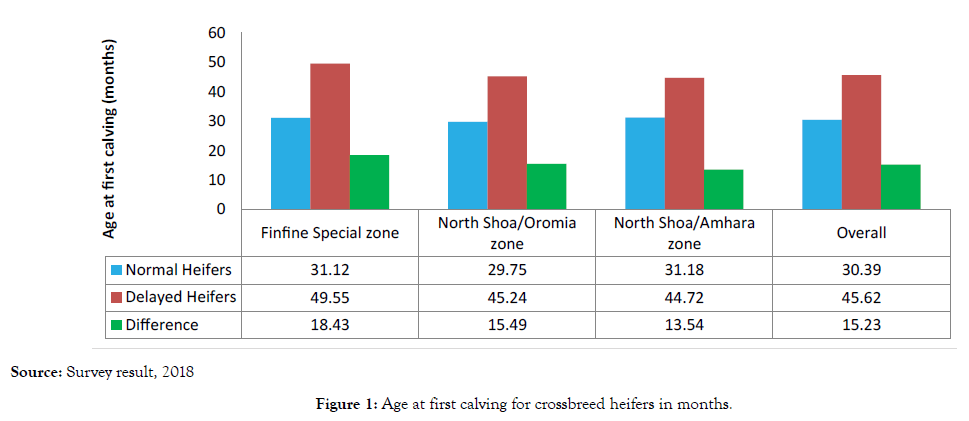
Figure 1: Age at first calving for crossbreed heifers in months.
Age at first calving for local zebu heifers also showed that the overall mean for fertile heifers was 35.39 months and 52.52 months for delayed heifers. The mean difference was 17.13 months. The high delay was seen in the North Shoa-Oromia zone (17.04 months) and low in the North Shoa-Amhara zone (15.05 months) (Figure 2). The result revealed that on average a farmer faces an economic loss of 17.13 months. Empirical studies showed that age at first service reported in Ethiopia includes about 53 months for highland Zebu [12], 55 months for Horro cattle, 53.9 months for Borana cattle inseminated artificially [13] and 34.4 months for Ogaden cattle [14]. The overall estimated average age at first calving was found to be 40.9 months, of which 47.16 months for local cows, and 37.95 months for crossbreed cows [15].
Source: Survey result, 2018
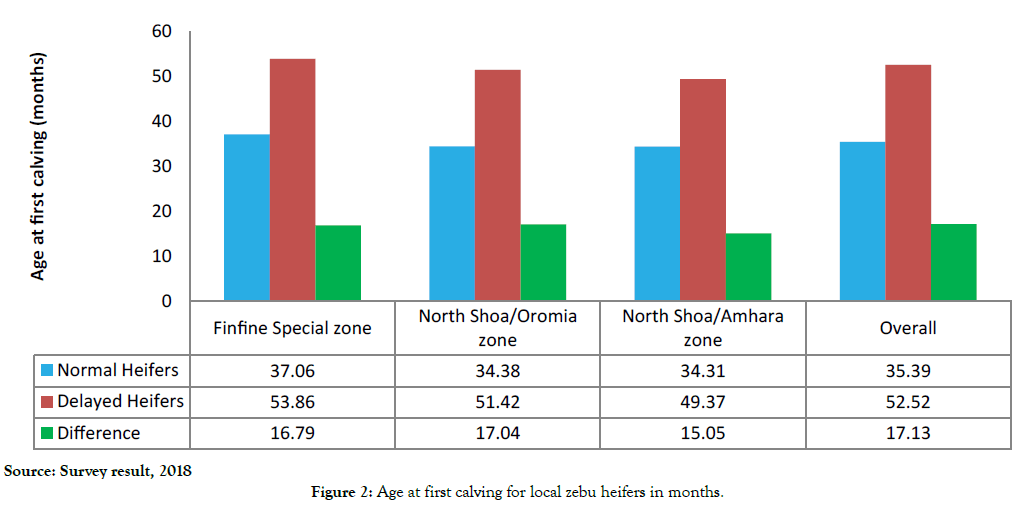
Figure 2: Age at first calving for local zebu heifers in months.
Calving interval
The calving interval is also the most important factor which affects the efficiency of dairy cows. The mean calving interval of crossbreed cows is 12.4 months for fertile cows and 19.19 for delayed cows which showed 6.79 months delay. The low delay was seen in the Finfine special zone (5.98 months) and high delay in the North Shoa-Oromia zone (7.44 months) (Figure 3).
Source: Survey result, 2018
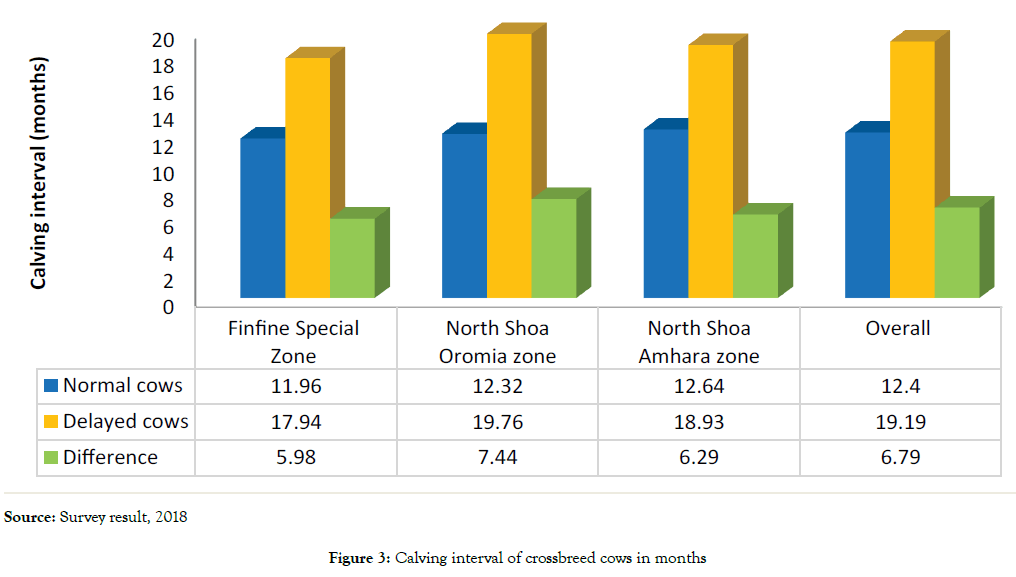
Figure 3: Calving interval of crossbreed cows in months.
The calving interval of local zebu cows also revealed the overall mean calving interval of delayed local zebu cows was 24.03 months and 14.53 for fertile cows. The difference or delay was 9.53 months. The highest delayed months were observed in the Finfine special zone (9.98 months) and the lowest at the North Shoa-Amhara zone (7.77 months) (Figure 4). The study by Mulugeta and Belayeneh, [15] showed that the mean calving interval of local and crossbreed dairy cows was 23 months (24.94 months for local cows and 22 months for crossbred). Based on the result crossbreed cows calving interval was shorter and better than local cows.
Source: Survey result, 2018
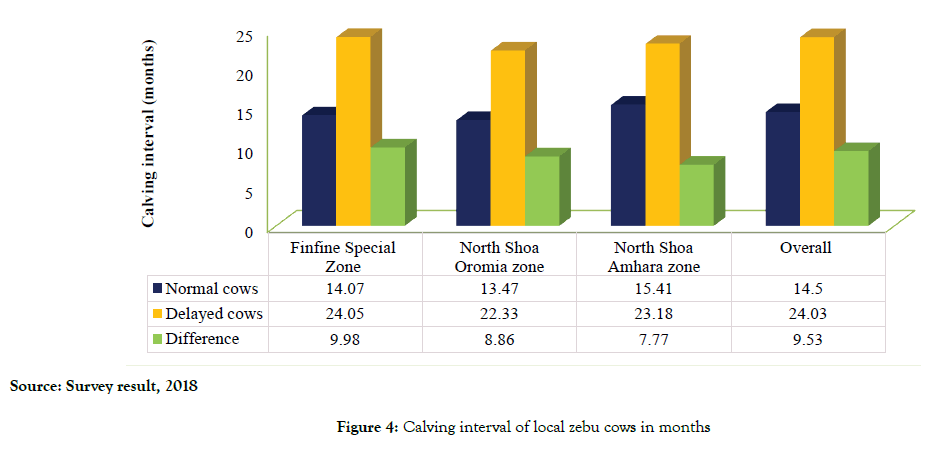
Figure 4: Calving interval of local zebu cows in months.
Dairy cattle reproductive status
The study has assessed the delayed conception rate of both local and crossbreed cows and heifers. The result showed that the mean delayed conception rate of local zebu cows was 26% which was higher in the Finfine special zone (29%) and lower in the North Shoa Oromia zone (22%). The fertility status of crossbred cows in the study zones also showed a high delayed conception rate at the North Shoa Amhara zone (35%) and a low delayed conception rate at the North Shoa Oromia zone and Finfine special zone (30%) with a mean of 32% (Figure 5).
Source: Survey result, 2018
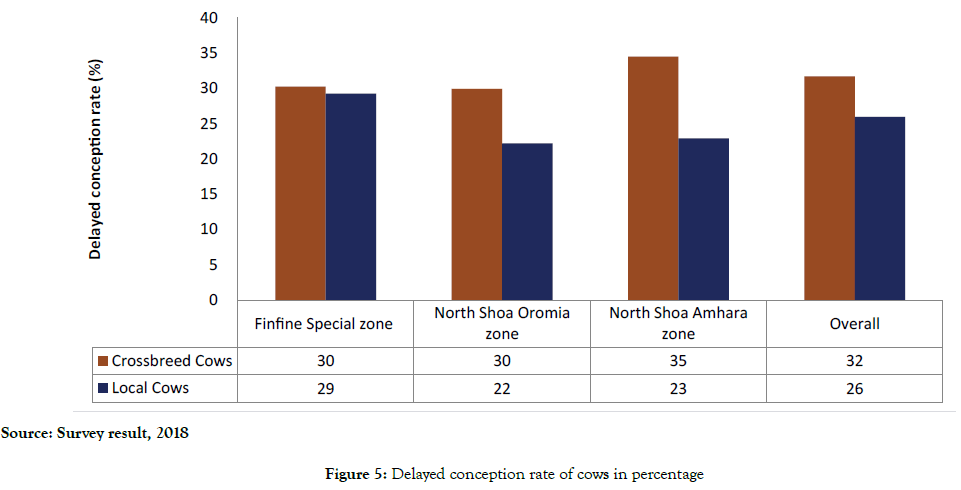
Figure 5: Delayed conception rate of cows in percentage.
The delayed conception rate of local zebu heifers also revealed that the mean delayed conception rate was 36% with a high rate of delayed conception at Finfine special zone (37%) and a low rate in the North Shoa Amhara zone (35%). Whereas, the highest delayed conception rate of crossbreed heifers was observed in the Finfine special zone (33%) and the lower at North Shoa Oromia zone (19%). The mean delayed conception rate of crossbreed heifers was 25% (Figure 6).
Source: Survey result, 2018
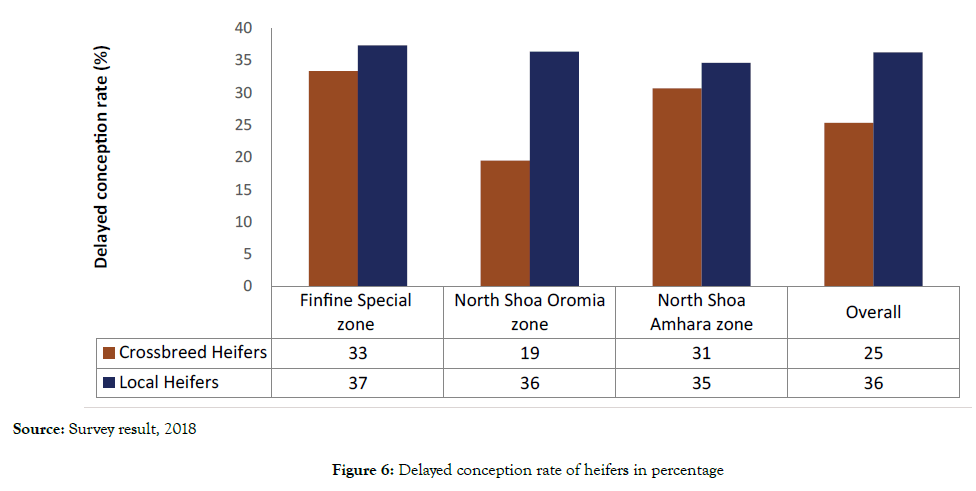
Figure 6: Delayed conception rate of heifers in percentage.
Economics of dairy cattle delayed conception
A crossbreed cow is said to be reproductively poor if and only if its calving interval is above 14 months (exclude 14). On the other hand, crossbreed heifer is called reproductively poor if the age at first calving of the heifer is 36 months. Hence, the age at first calving for the normal crossbreed heifers’ ranges between 25 and 36 months in normal condition. Otherwise, it is considered reproductively poor (37 months and above) as suggested by Falvey and Chantalakhana [8] and Mulugeta and Belayeneh [15]. The calving interval for local zebu cow is between 12 and 19 months and the age at first calving for the local zebu heifers ranges between 36 and 48 months. If these conditions are not fulfilled, they are considered reproductively poor.
Economics of poor reproductive performance in cows
The study used milk and calf as losses comes due to poor reproductive performance. Feed cost, treatment cost, breeding cost, and labor costs are extra costs that were also used for the analysis. Using these variables, the mean annual cost of the poor reproductive performance of the crossbreed cow is ETB 32,068.53 (US $ 1,167.40). The cost is high at North Shoa-Oromia zone (ETB 35,218.51 or US $ 1,282.07) and low at Finfine special zone (ETB 27,749.88 or US $1,010.19). The mean per day poor reproductive performance cost for crossbreed cows is ETB 157.43 (US $5.73) considering the days delayed. The per-day mean cost is high in the North Shoa-Amhara zone (ETB 159.00 or US$ 5.79) and low in the Finfine special zone (ETB 154.68 or US $5.63).
The poor reproductive performance cost of local zebu cattle also showed that the mean annual cost of poor reproductive performance is ETB 15,696.34 (US $ 571. 39) which is high in the North Shoa Oromia zone (15,835.31 or US $576.46) and low in North Shoa Amhara zone (ETB 14,198.85 or US $ 516.89). The mean per cow per day cost is high at the North Shoa-Amhara zone (ETB 60.91 or US $ 2.22) and low at Finfine special zone (ETB 50.57 or US $1.84) with a mean of ETB 54.90 (US $2.00) (Table 8).
| No. | Costs of delayed conception per delayed days | Crossbreed cows | Local zebu cows | ||||||
|---|---|---|---|---|---|---|---|---|---|
| Finfine Special Zone (n=52) |
North Shoa Oromia (n=126) |
North Shoa Amhara (n=120) |
Overall (n=298) | Finfine Special Zone (n=52) |
North Shoa Oromia (n=126) |
North Shoa Amhara (n=120) |
Overall (n=298) | ||
| 1 | Breeding Cost | 154.00 | 163.00 | 147.00 | 155.00 | 167.00 | 183.00 | 163.00 | 172.00 |
| 2 | Extra Labor Cost | 365.98 | 450.86 | 643.47 | 497.03 | 610.78 | 536.92 | 794.87 | 697.60 |
| 3 | Extra Feed Cost | 10,964.93 | 13,641.98 | 11,533.34 | 12,450.14 | 5,491.00 | 4,874.77 | 4,275.05 | 5,243.41 |
| 4 | Extra Medical Cost | 118.40 | 145.08 | 122.66 | 132.41 | 197.6 | 172.77 | 151.52 | 185.84 |
| 4 | Cost of Milk Loss | 15,045.49 | 18,149.78 | 16,275.45 | 17,016.20 | 7,781.29 | 8,856.80 | 7,963.81 | 8,376.81 |
| 6 | Cost of Calf Loss | 1,101.09 | 2,667.80 | 1,282.07 | 1,817.75 | 891.89 | 1,211.05 | 850.60 | 1,020.69 |
| The annual cost of delayed conception | 27,749.88 | 35,218.51 | 30,003.99 | 32,068.53 | 15,139.56 | 15,835.31 | 14,198.85 | 15,696.34 | |
| Cost/cow/day in ETB | 154.68 | 157.79 | 159.00 | 157.43 | 50.57 | 59.58 | 60.91 | 54.90 | |
| Cost/cow/day in US$ | 5.63 | 5.74 | 5.79 | 5.73 | 1.84 | 2.17 | 2.22 | 2.00 | |
Table 8: Summary of cost of poor reproductive performance of cows.
Based on the result a high proportion of poor reproductive performance cost of crossbreed cows goes to milk loss (53%) and feed cost (39%). The highest proportion of the cost of poor reproductive performance of local zebu also goes to the cost of milk loss (53%) and the cost of extra feed (Figure 7).
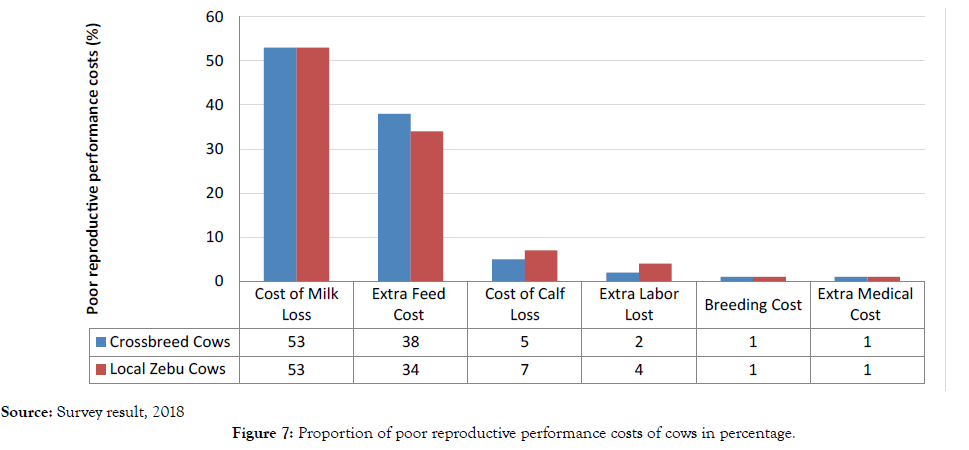
Figure 7: Proportion of poor reproductive performance costs of cows in percentage.
Economics of poor reproductive performance in Heifers
The cost of delayed conception in heifers both for crossbreed and local zebus has also been observed. The result of the study showed that the cost of delayed conception for crossbreed heifers is ETB 69,333.59 (US $2,523.97) which is high at Finfine special zone (ETB 83,117.55 or US $3,025.76) and low in the North Shoa- Amhara zone (ETB 62,793.82 or US $2285.91). The mean per heifer per day is high at the North Shoa-Amhara zone (ETB 154.59 or US $5.63) low at Finfine special zone (ETB 150.33 or US $ 5.47) with a mean of ETB 151.75 (US $5.52). Concomitantly, the mean cost of the delayed conception of local zebu heifers along the study zones is ETB 27010.75 (US $983.28). It is low at Finfine special zone (ETB 24,478.93 or US $891.12) and high at North Shoa-Oromia zone (ETB 28,805.72 or US $1,048.62). The mean per day per heifer cost is ETB 52.56 (US $1.91) which is high in the North Shoa-Amhara zone (ETB 58.57 or US $ 2.13) and low in the Finfine special zone (ETB 48.57 or US $1.77) (Table 9). About 55 and 56% of the cost goes to milk loss for crossbreed and local zebu heifers, respectively. On the other hand, extra feed cost is the second important cost of heifers’ poor reproductive performance which constitutes 40 and 35% to the total poor reproductive performance cost to crossbreed and local zebu heifers, respectively (Figure 8).
Source: Survey result, 2018
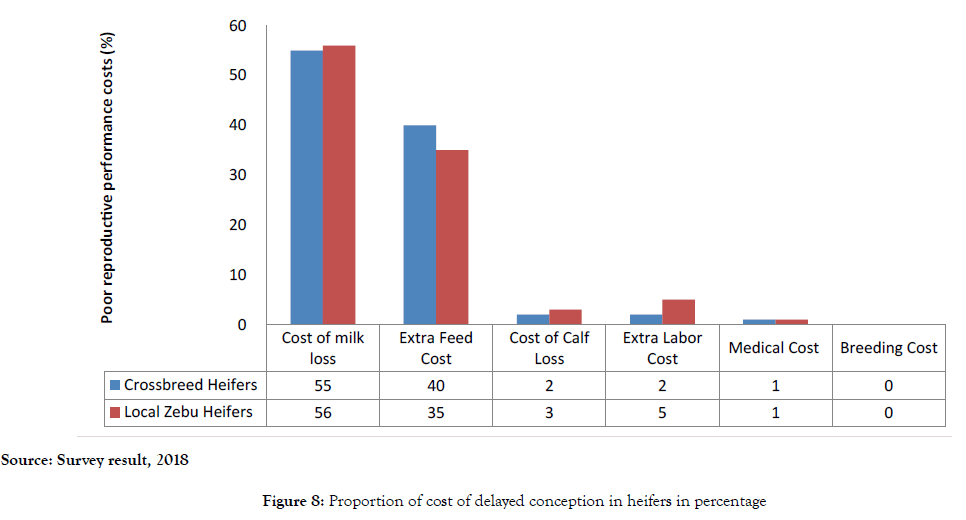
Figure 8: Proportion of cost of delayed conception in heifers in percentage.
| No. | Costs of delayed conception per delayed days | Crossbreed heifers | Local zebu heifers | ||||||
|---|---|---|---|---|---|---|---|---|---|
| Finfine Special Zone (n=52) |
North Shoa Oromia (n=126) |
North Shoa Amhara (n=120) |
Overall (n=298) | Finfine Special Zone (n=52) |
North Shoa Oromia (n=126) |
North Shoa Amhara (n=120) |
Overall (n=298) | ||
| 1 | Breeding Cost | 158.00 | 167.00 | 164.00 | 165.00 | 206.00 | 119.00 | 162.00 | 189.00 |
| 2 | Extra Labor Cost | 1,127.92 | 938.09 | 1,385.14 | 1,114.84 | 1,028.16 | 1,032.62 | 1,520.18 | 1,253.92 |
| 3 | Extra Feed Cost | 33,793.25 | 28,384.13 | 24,826.94 | 27,925.73 | 9,243.36 | 9,375.41 | 8,175.97 | 9,424.93 |
| 4 | Medical Cost | 364.91 | 301.86 | 264.03 | 296.99 | 332.64 | 332.28 | 289.77 | 334.04 |
| 5 | Cost of milk loss | 46,369.29 | 37,763.24 | 35,034.91 | 38,167.42 | 13,098.76 | 17,033.85 | 15,230.67 | 15,057.17 |
| 6 | Cost of Calf Loss | 1,304.18 | 2,297.89 | 1,118.80 | 1,663.62 | 570.01 | 912.56 | 730.43 | 751.70 |
| The annual cost of delayed conception | 83,117.55 | 69,852.21 | 62,793.82 | 69,333.59 | 24,478.93 | 28,805.72 | 26,109.01 | 27,010.75 | |
| Cost/cow/day in ETB | 150.33 | 150.41 | 154.59 | 151.75 | 48.57 | 56.35 | 58.57 | 52.56 | |
| Cost/cow/day in US % | 5.47 | 5.48 | 5.63 | 5.52 | 1.77 | 2.05 | 2.13 | 1.91 | |
Table 9: Summary of cost of poor reproductive performance of dairy cattle.
Empirical studies showed that a one day of delayed conception on net return per year ranged from 0.3 Sweden Krona to 11.6 Sweden Krona [16]. In another study, the mean reduction in net revenue from a 1-day increase in adjusted calving interval was Canadian $4.7 per cow [17]. Esslemont et al., [18] also estimated that per day lost due to per day of delay was £1.73 when the calving interval was extended from 85 days to 100 days post-calving. The cost cumulated overtime was £253 when the calving interval extends by 3 months. Anonymous (2005) also estimated that each extra day of calving interval costs from £1.30 to £5.00. De Vries [19] estimated the cost per extra open day varied from $3.19 to $5.41. On the other hand, estimated the economic loss due to poor reproductive performance loss per cow was US $4,927 [20].
The estimated cost of delayed conception
The study has finally estimated total economic loss as a central highland and as a country as a whole. The data for the number of crossbreed and local zebu cows used in estimation was found from CSA, [21] report of livestock and livestock characteristics. The estimated result showed that the poor reproductive performance of crossbred cows annually costs ETB 6,859,474,761.61 (US $249,707,854.45). On other hand, the local zebu cattle poor reproductive performance costs ETB 131,700,917,393.51 (US $4,794,354,473.74). The estimate of the loss as Ethiopia is just a rough estimate since it did not consider the production system of the non-sampled area. The delayed conception cost of crossbreed and local zebu heifers in central highland is estimated to be ETB 2,053,022,879.41 (US $74,736,908.61) and ETB 14,802,637,790.05 (US $538,865,591.19), respectively (Table 10).
| Location of the estimate | Number of exotic and crossbred cows | % reproductively poor cows | Cost of poor reproductive performance per cow per lactation in ETB | Total loss due to poor reproductive performance in ETB | Number of local zebu cows | % reproductively poor cows | Cost of poor reproductive performance per cow per lactation in ETB | Total loss due to poor reproductive performance in ETB |
|---|---|---|---|---|---|---|---|---|
| North Shoa Amhara zone | 26,614 | 34.50 | 30,068.53 | 276,084,130.81 | 559,898 | 22.92 | 14,198.85 | 1,822,118,848.81 |
| North Shoa Oromia zone | 95,031 | 29.91 | 35,218.51 | 1,001,042,901.94 | 747,834 | 22.22 | 15,835.31 | 2,631,333,111.16 |
| West Shoa zone | NA | 30.23 | 27,749.88 | NA | 1,136,141 | 29.23 | 15,139.56 | 5,027,757,255.14 |
| Arsi zone | 92,492 | 30.23 | 27,749.88 | 775,895,846.66 | 1,202,503 | 29.23 | 15,139.56 | 5,321,428,574.95 |
| Central highlands | 2,053,022,879.41 | 14,802,637,790.05 | ||||||
Table 10: Estimate of poor reproductive performance cost in central highlands.
According to FAOSTAT (2018), Ethiopia has imported 2,370 tons of milk which were valued 12.7 million US$ in 2016. The finding of this report realized that milk loss due to a poor reproductive performance from cows was estimated to be 957,531 tons which are valued 331.7 million US$. So, the reduction of poor reproductive performance in cows in central highlands alone could cease the current milk import of the country.
Remarks: 27.47ETB=1USD$
Source: Survey result, 2018.
Mayne et al., [22] studied that poor reproductive performance is a major problem on dairy farms throughout the United Kingdom (UK) and has been identified as the single most important problem in dairy herd management in Northern Ireland. The direct financial cost due to poor reproductive performance was estimated to be approximately £50 million per annum in Northern Ireland (or £9000 per farm). Kafi et al., [10] estimated that the net cost due to one day of delay in conception for a cow producing 25 liters of milk in peak lactation was estimated at 40591.98 Rials (US $4.51) when conception was delayed from 85 days to 100 days post-calving. This loss increased to 60120.89 Rials (US $6.68) per day when conception occurred at 146 days to 175 days post-calving. Seeger [23] estimated the economic consequences due to the non-optimal reproductive performance of a herd. The result showed profit loss associated with a 1-day increase of calving interval may vary from negative values to €5 or US $6, depending on a large number of factors. Khan et al., [24] studied the impact of delayed conception on the calving interval of the animal. The study found that animals that conceive at a later stage of lactation showed a decline in financial returns by 24% to 27% than those that conceived earlier.
Inchaisri et al., [25] estimated that the economic losses due to nonoptimal fertility in an average reproductive performance cow were €34 per cow per year as compared to the losses of €231 per cow per year in a good reproductive situation cow. Tamador-Elkhansaa and Moamer [26] estimated the economic loss due to poor reproductive performance in crossbred dairy cows in Eastern Nile Locality. The total annual loss accounted for US $418,779.1, loss per farm was US $34,898.261 and loss per cow was US $4,927. Milk loss accounted for 89% of the total cost. Raising the awareness of the farmers towards better management of poor reproductive performance problems will act to increase their income as well as milk supply.
Poor reproductive performance of dairy cows and heifers affects the profit margin of the cattle by increasing management and veterinary costs without a major output (milk). The study has been conducted to quantify the economic loss due to poor reproductive performance of dairy cows/heifers in the central highlands of Ethiopia. The result of the study revealed that the mean annual cost of poor reproductive performance of crossbred cows and heifers was enormously high. A high proportion of poor reproductive performance cost of crossbreed cows and heifers went to milk loss and feed cost. Alongside this, the mean cost of the delayed conception of crossbreed and local zebu heifers along the study zones was high though lower than the crossbreed counterparts and more than half of the cost goes to milk loss. The study allows us to infer that the country is losing a huge amount of money due to poor reproductive performance/delayed conception of dairy cattle.
Increased domestic dairy production through the use of productive animals especially crossbreed cows, particularly at smallholder dairy farm level, has the potential for dairy development as the milk yield is significantly high. Moreover, the use of improved cattle reduces the age at first calving and calving interval which in turn reduces the loss which comes due to poor reproductive performance. The lactation length of the crossbreed cows is also relatively longer than the local zebus. Hence, an appropriate policy is required to encourage the development of improved dairy cattle.
Culling is not common among farmers of the study areas. However, it has a substantial contribution to the loss caused by poor reproductive performance. Especially, feeding cost, breeding cost, and veterinary cost have a significant effect on the income of the farmers. So, there is a need to minimize these costs through culling in order to reduce the economic loss of poor reproductive performance.
Based on the finding, AI inefficiency causes economic loss directly by increasing the breeding cost and indirectly through prolonging age at first calving and calving interval. In order to overcome the poor reproductive efficiency, the inseminator should be trained for insemination technique, semen handling and should be educated for semen selection.
Awareness must also be created among the farmers regarding balanced rations and minerals in order to improve production as well as fertility (reproduction) of female dairy cattle. Moreover, farmers should be trained in order to detect the heat of the animal at the proper time with proper feed.
Citation: Diro S, Mamo T, Getahun W, Mebratu WGT, Musemma R (2021) The Economic Loss of Dairy Cattle Poor Reproductive Performance in Central Highlands of Ethiopia. J Adv Dairy Res. 9: 248.
Received: 30-Jan-2021 Accepted: 12-Feb-2021 Published: 19-Feb-2021 , DOI: 10.35248/2329-888X.21.9.248
Copyright: © 2021 Diro S, et al. This is an open access article distributed under the term of the Creative Commons Attribution License, which permits unrestricted use, distribution, and reproduction in any medium, provided the original work is properly cited.